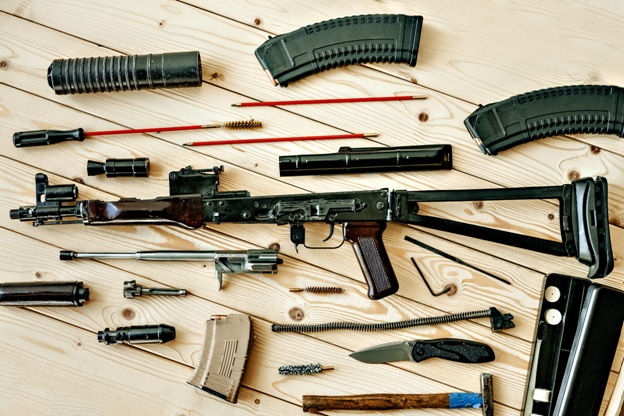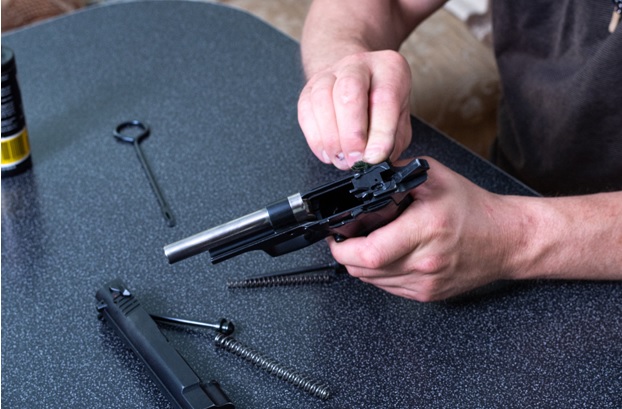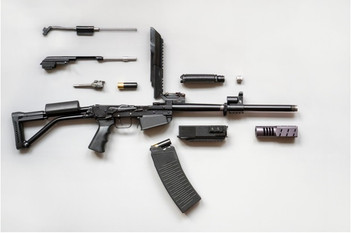Firearm Parts and Function
Jul 28th 2023
Notwithstanding the fact that each firearm action is very different, and that not all firearms have the same parts, most of them share a lot of mechanical common ground.
This short post will cover all of the major firearm parts, most of which can be found on all firearms, and what they do.
What Are the Major Firearm Parts and Their Purpose?
The following are nearly universal firearm parts:
- Barrel: The barrel is effectively a metal tube with a hole (the bore) through the middle. When the primer ignites the propellant, it deflagrates and produces expanding gases. These are trapped in the chamber and bore behind the projectile and propel it forward. A barrel may be rifled (grooved) or unrifled (smoothbore). Rifled barrels impart spin to the projectile, creating spin-stability and improving accuracy.
- Receiver or frame: Most firearms contain a part called the receiver, which accepts, or “receives,” all of the other components, including the barrel, trigger assembly, magazine, action, grip, and stock. Some firearms, like handguns (including revolvers) have what is called a frame instead, but which performs basically the same function.
- Stock or grip: The grip is the component that serves as an interface for the shooter’s hand. All modern breech-loading arms have a grip, and shoulder mounted long-arms also have a stock that is placed against the shoulder and used to improve stability.
- Trigger: The trigger is a flat or curved bar of metal that, through a metal part called the sear, detains the mainspring and firing pin, hammer, or striker until depressed, at which point it releases them, striking the primer and igniting the propellant charge, firing the weapon.
- Trigger guard: The trigger guard is a flat, curved piece, typically of metal or polymer, that helps prevent accidental contact with the trigger.
- Sights: Most firearms have sights (or, in the case of a shotgun, a bead) consisting of front and rear sights which the shooter can line up with the bore in order to aim the firearm.
- Action: The action is a collection of parts responsible for the 8 basic functions listed in the next part of this article. There are many types of actions, including single and double shot, pump or slide, bolt-action, lever action, and a variety of semi-automatic and automatic actions, including but not limited to gas impingement, gas-operated roller delay blowback, direct blowback, and recoil-operated. The action contains the bolt or bolt carrier, the firing pin and spring, extractors, ejectors and springs, and locking lugs.
- Magazine: A magazine is a component, often removable from the firearm, which houses unfired, live rounds and feeds them, under spring tension, into the firearm’s action.

What Are the 8 Basic Functions of a Firearm Action?
The parts mentioned above are responsible for the following primary functions of a breech-loading firearm.
Effectively all breech-loading arms, including repeaters and single-shot firearms, produce the same 8 basic actions:
- Feeding: With the exception of single and double-shot break actions that require the operator to individually insert the rounds into the chamber, modern firearms’ actions feed the ammo from the mag into the chamber. The bolt or carrier strips a round off the top of the mag, guiding it up the feed ramp.
- Chambering: As the stripped round moves up the feed ramp, the nose enter the chamber, as this occurs, in most firearms, the extractor grips onto the rim of the cartridge. If the firearm has an ejector, the ejector is compressed as the round moves into the chamber.
- Locking: Each action is a little bit different, but after chambering the round, locking lugs on the bolt/bolt carrier group fit into recesses on the barrel, barrel extension, or receiver. For semi-autos and repeaters, these locking lugs disengage upon firing. Some single shot and double shot firearms have an action bar/lever that is required to manually disengage the locking lugs, whether or not the firearm has been fired.
- Firing: With the round chambered and the action closed and locked (and cocked), the firearm can be fired. Depressing the trigger causes the trigger bar to slide out of alignment from the sear. The sear detains the mainspring which provides potential energy to drive the hammer, firing pin, or striker forward. When the sear releases the spring/hammer, it strikes the firing pin, which moves forward, striking and igniting the primer at the base of the cartridge. When the primer ignites, the propellant charge deflagrates, and chamber pressure builds. As gases continue to expand, the projectile or shot charge is pushed forward, through the barrel, and out at the muzzle.
- Unlocking: Unlocking occurs through different processes depending on the action style. For instance, in a gas impingement system, the gas tube conveys gas to the bolt carrier group, forcing it to the rear. The path of the bolt cam pin follows the cam track, rotating the bolt carrier until the locking lugs are no longer engaged into the barrel extension. On other firearms, such as a bolt-action repeater, the bolt handle must be manually rotated upward to disengage the locking lugs.
- Extracting: Since the extractor has already engaged the casing rim, opening the action or manually cycling the bolt carrier automatically pulls the spent cartridge rearward out of the chamber.
- Ejecting: For firearms that have ejectors, the ejector and spring are typically compressed against the body of the bolt/bolt carrier until it reaches a certain point of rearward progress. Once the spent shell clears the chamber, the ejector and spring release their energy by flinging the shell out of the ejection port.
- Cocking: After the shell is ejected, the bolt carrier continues to more rearward, forcing the hammer down and compressing the hammer spring. Trigger reset also occurs here, and closing the action feeds and chambers a new round, allowing the shooter to repeat the sequence.

Upgrade with Quality Firearm Parts
As stated, each platform has slightly different firearm parts and all actions work differently. Nonetheless, by upgrader trigger assemblies, bolt carrier groups, barrels, springs, buffer weights, and other gun parts, you can customize, even optimize the performance of your favorite firearm platform.
We carry a comprehensive selection of firearm parts on our website as well as in our showroom in 50 Hilton Street in Easton, Pennsylvania. If you can’t find what you’re looking for on our website, either come pay us a visit or call us at 610-250-3960 and we’ll help you find it.

